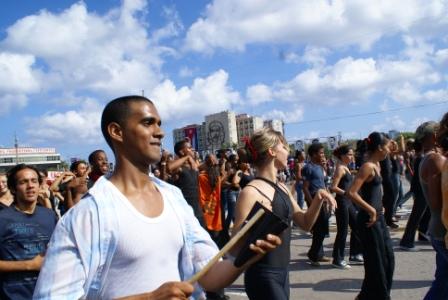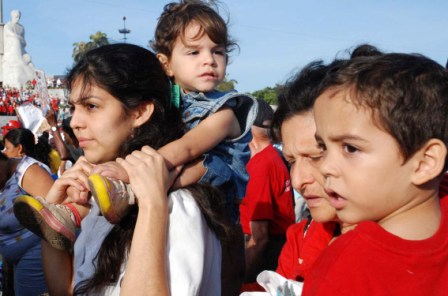Cuba’s May First Recap
By IRINA ECHARRY, photos by CARIDAD and ELIO DELGADO

HAVANA TIMES, May 2 – On this day it’s customary for Havana residents to flow out onto Revolution Square and parade before the monument of their national hero, José Martí. It is also a tradition to listen to words of revolutionary reaffirmation. Workers, students and retirees began assembling in the early morning hours to later shout slogans and wave their paper flags.
Playing a leading role this year were the country’s colors-red, white and blue-which speckled the Cuban capital’s streets. Hundreds of thousands of flags, tee-shirts and posters with those same colors added more variety to this great mass of workers under the tropical sun, which at times retaliates with vengeance against all those who decided to participate.
I doubt that on May 1, 1886, any of those who marched in the first great demonstration of workers in Chicago could imagine that a century later the working people of Cuba would likewise take to the streets, though they are not demanding higher wages or better working conditions. And many of our youths don’t know why this particular day is celebrated.

I went up to a young guy and asked him why he came to the square. “To show my support to the communist Cuban youth,” replied Elmer, “but I don’t know where this celebration came from.” He was walking in front of the grand dais hoping to catch a glimpse of our highest political leader.
Another marcher, Juan Miguel-a good bit older but still under 40-said comes because it is a sign of great commitment to be here together with Raúl Castro, and he immediately answers that Chicago was where the first such demonstration took place.
María de la Ángel, a retiree who still participates in the parades “from conviction,” said, “Until the mid-80s the calling of the May Day parade was by the unions, that is to say, by the rank-and-file. Each of the sectors of labor used to organize their own initiatives. You might have seen a procession of youth dressed as militia members, or a paper-decorated tractor rolling along by your side, as you listened to an orchestra in the background.
“Or, suddenly, there would appear a float-with big jagged wheels-representing the sugar mill workers. It was better back then because people identified more with their field of work. Now, Maria says that the parades are organized by neighborhood, but notes that not everybody works in the neighborhood where they live. That’s why people no longer feel the same enthusiasm. Cubans have many things to celebrate; we should do it with feeling and a sense of joy!”

Milesia Rodriguez is a Cuban who admires the Revolution and believes that it is part of a struggle of the entire world. She has been designated a model worker for several years in a row and has never missed one of these marches.
Carmen Hernandez, who is employed by the Ministry of Public Health, turns out to support Fidel and her field of work.
Yander is a high school student specializing in computer science; he came along with his classmates and teachers.
Mariano Guzman is a veteran of the Bay of Pigs clash. He wore his beret from back in that time, the same one he’s worn to every march, his eyes misting up whenever he thinks back to those days.
This year the municipality of Plaza represented the cultural workers sector, which is why there was no shortage of congas, trumpets, dancing and even a few shots of rum to support the several hours of waiting for the parade to begin.

For children May Day a veritable party. They only know that it is a different kind of day, as several of them masquerade as mambise independence fighters or African deities, or are carried on their parents’ shoulders. Then there are those who shout along with the adults; though they don’t understanding what they’re saying. They have only rarely seen so many people together, and so many colors, flags, and so much music.
There are cheerful people and less cheerful ones, curious people and experts of the routine, foreigners who only come on this date and many more who study here and are thankful for the opportunity.
When the fluttering of flags concludes, and the happiness and balloons float away, the street is full of cardboard signs that only minutes before had served to proclaim the loftiest of ideas.
It’s now the street sweepers turn, they are the workers who must struggle against the oppressive winds characteristic of this day, as one by one they pick up all the homemade signs that now lie useless.
The music has ceased, and everyone has returned to their homes or gone to the beach. Some will continue the celebration; others will take advantage of the half day of rest.
Click on the thumbnails to see all the photos in this gallery






























Learn something new every day 🙂